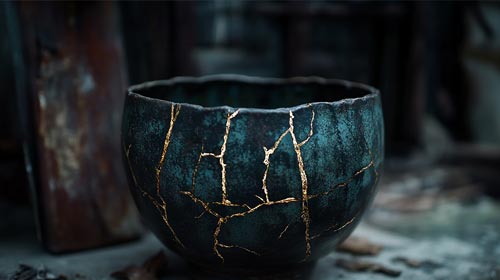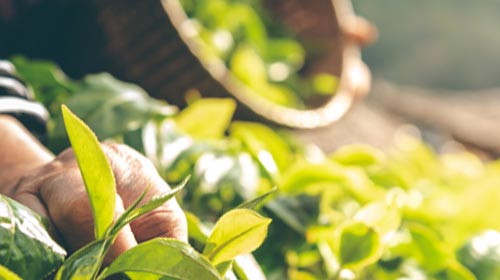Sometimes what breaks is the beginning of something new. In Japanese kintsugi—the art of repairing broken things with gold—this very thing becomes visible. Instead of hiding cracks, they are emphasized. Refined. Honored. Kintsugi takes on a particularly significant meaning in the context of tea. For hardly any object is treated as carefully and used as frequently as a tea bowl. And if it breaks? Then another part of the story begins.
What is Kintsugi? Origin and Meaning
Kintsugi (金継ぎ, "gold bonding") is a traditional Japanese repair technique in which broken pottery is reassembled using lacquer and gold dust. The method originated in the 15th century, presumably at the court of the shogun Ashikaga Yoshimasa, who had a damaged tea bowl repaired—and with the elaborate gilding, laid the foundation for a new aesthetic.
Kintsugi follows the philosophy that damage and breakage should not be hidden, but made visible – as part of an object's history. A crack is not a weakness. It is character. A memory. A value.
Kintsugi and Wabi-Sabi – kindred spirits
Kintsugi is often mentioned in connection with wabi-sabi – the Japanese philosophy that recognizes beauty in imperfection. While wabi-sabi visualizes the passage of time, kintsugi emphasizes the moment of rupture. Both concepts emphasize that it's not perfection that counts, but authenticity.
A repaired tea bowl doesn't replace the original—it becomes something new. It bears visible marks, but these are precisely what make it special. In a world that often seeks flawless surfaces, Kintsugi reminds us that healing lies not in undoing, but in consciously moving forward.
Kintsugi in tea culture
In the Japanese tea ceremony, every object has significance—especially the chawan , the tea bowl. It is treated with respect and carefully presented, yet is also an everyday object of use. If a chawan breaks, it's not a flaw, but a turning point.
Many tea masters had their bowls repaired with Kintsugi. The golden lines tell of moments of carelessness or simply the passage of time. Instead of being discarded, the bowl remains part of the ritual—now with even more history, depth, and dignity.
Kintsugi as an inner attitude
Kintsugi is not just a technique, but a philosophy. It's about recognizing your own "rift," accepting it, and moving forward—not despite, but with everything that has been.
This attitude can also be felt while drinking tea. A chipped edge, a small crack – instead of disrupting the moment, they remind us that nothing stays the same. Tea becomes an exercise in acceptance, in mindfulness, in honesty.
The golden seam in the bowl can thus become a symbol for one's own life: for vulnerability, transformation and strength.
Growing Karma and the idea of Kintsugi
At Growing Karma, we celebrate not only the plant, but also the process. Our tea plants are grown in Germany – under natural conditions, with patience and dedication. They aren't perfect, but they are authentic. Just like our tea tools: handmade, individual, with visible traces of production.
When a bowl breaks, its story doesn't end. Some are repaired – visibly, openly, consciously. We don't see this as a flaw, but rather as part of the journey. And this idea extends to all of our work: Tea isn't a product that always has to be the same. Every harvest is different. Every infusion is new.
Those who cultivate a Growing Karma tea plant learn to grow with it—even when things don't go smoothly. Perhaps Kintsugi is exactly that: a symbol of living in relationship to what is—rather than what should be.
Kintsugi in everyday life – with tea as a companion
You don't need a broken shell to understand Kintsugi. Perhaps it's enough to pause for a moment. Not to cover up a crack, but to see it. Perhaps even within yourself.
A short tea break can be the first step. Sit down. Give yourself time. Drink mindfully. Look at your teacup. Feel the rim. The bottom. The story it tells – with or without gold.
Tea isn't perfect. It's alive. Just like you.
Kintsugi reminds us that beauty doesn't have to be smooth. It can have cracks. And gold. And depth. Perhaps your journey there begins with a cup of tea—and the courage to embrace imperfection.




Leave a comment
This site is protected by hCaptcha and the hCaptcha Privacy Policy and Terms of Service apply.